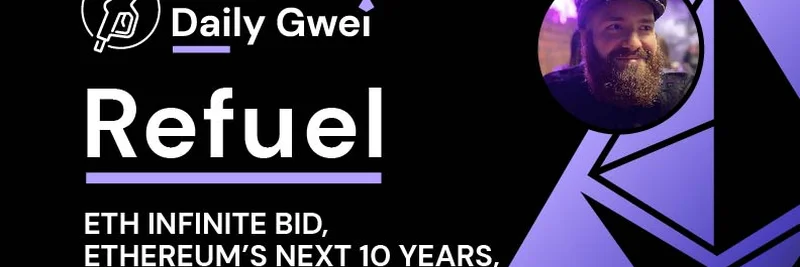Ethereum enthusiasts got a fresh dose of insights yesterday when Anthony Sassano, better known as @sassal0x on X, dropped a tweet promoting the newest episode of The Daily Gwei Refuel. If you're not familiar, The Daily Gwei is a go-to source for Ethereum updates, hosted by Sassano himself, breaking down the latest happenings in the Ethereum and crypto world every weekday. This episode, numbered 845, covers some hot topics that could shape the future of blockchain—and yes, that includes the wild world of meme tokens.
In his tweet, Sassano teases key discussions: the "ETH infinite bid," Ethereum's roadmap for the next 10 years, stablecoin Layer 1 chains (or L1's), and a bunch more. He links directly to the YouTube video, making it easy to dive in. Let's unpack these topics in simple terms and see why they matter, especially if you're into meme tokens on Ethereum's ecosystem.
The ETH Infinite Bid: Why Demand for Ethereum's Native Token Seems Unstoppable
First up, the "infinite bid" on ETH refers to the idea that there's endless buying pressure on Ethereum's native cryptocurrency, ETH. In the episode, Sassano highlights how "ETH treasury companies" are gobbling up ETH like there's no tomorrow. Take Bitmine, for example—they're aiming to hold a whopping 5% of the total ETH supply, which is around 6 million ETH. Right now, they've got about 1.2 million in their coffers.
This isn't just corporate hoarding; it's fueled by massive inflows into ETH exchange-traded funds (ETFs). We're talking over $1 billion in a single day and more than $2 billion weekly—numbers that even outpace Bitcoin ETFs lately. For meme token fans, this is huge. A stronger ETH price means more liquidity in the ecosystem, making it easier to launch, trade, and hype up those viral tokens on Ethereum Layer 2 solutions like Base or Arbitrum. Plus, with ETH as the gas for transactions, rising demand could stabilize fees, letting meme creators focus on the fun stuff without breaking the bank.
Ethereum's Next 10 Years: From Defense to Beast Mode
Sassano dives into a thread from Justin Drake, a key Ethereum researcher, outlining the network's evolution over the next decade. Drake breaks it down into phases: "fort mode" for beefing up economic security (think protecting against attacks), "beast mode" for massive scaling to handle way more users, and a "lean Ethereum" that's efficient and powered by tech like zero-knowledge virtual machines (ZKVMs) and data availability sampling.
In plain English, ZKVMs are like super-secure calculators that prove transactions without revealing all the details, while data availability sampling helps ensure data is accessible without overwhelming the network. Protocol updates mentioned include bumping the L1 gas limit to 100 million (gas is basically the fuel for Ethereum transactions) and "history expiry" to keep node sizes manageable—nodes are the computers that run the network.
There's also talk of multi-dimensional fee markets, which would separate fees for different activities, like cheap stablecoin transfers versus complex automated market maker (AMM) trades. AMMs are the backbone of decentralized exchanges (DEXs) where a lot of meme token swapping happens. If implemented, this could make meme trading even smoother and cheaper on Ethereum.
On the enterprise side, the Ethereum Foundation (EF) has a team chatting with big banks, tech giants, and governments about adoption. And get this—Ethereum has had 100% uptime since its launch in 2015, as showcased on ethereumuptime.org. That's reliability you can bet on, unlike some other chains that have hiccups.
For the meme community, this long-term vision means Ethereum is gearing up to support explosive growth. Meme tokens thrive on speed and low costs, and with L2s already booming, these upgrades could turn Ethereum into the ultimate playground for viral crypto projects.
Stablecoin L1's: A New Frontier for Digital Dollars
Stablecoins are cryptocurrencies pegged to stable assets like the US dollar, used for trading without the volatility of ETH or BTC. The episode spotlights Circle announcing a new stablecoin-focused Layer 1 chain, with whispers that Stripe might follow suit. But Sassano notes that stablecoins are mostly powering DeFi (decentralized finance) right now, not everyday payments.
Why does this matter for memes? Stablecoins like USDC or USDT are the go-to for buying into meme tokens on DEXs. A dedicated L1 could mean faster, more efficient stablecoin operations, potentially integrating seamlessly with Ethereum's ecosystem. Imagine pairing stablecoins with meme launches for instant liquidity pools—it's a recipe for more accessible and hyped-up token drops.
Other Highlights: Reports, Preconfirmations, and Cost Reductions
The episode isn't all big-picture stuff. Sassano shouts out GrowThePie's 45-page report on Ethereum's 10-year journey, covering everything from its origins to the rise of L2s. It's a must-read for anyone building or investing in the space.
On the tech front, Taiko has rolled out pre-confirmations on mainnet, slashing block times to 2-3 seconds for faster transactions. And Spire's DA Builder is live, cutting data availability costs for rollups—those are the scaling solutions where many meme tokens live.
Wrapping it up, this Refuel episode is a reminder of Ethereum's momentum. Whether you're a hardcore dev, a casual trader, or deep into meme tokens, staying plugged into updates like these via The Daily Gwei can give you an edge. Head over to the YouTube link to watch the full thing, and keep an eye on how these trends fuel the next wave of blockchain innovation. What's your take on ETH's infinite bid—bullish for memes? Let us know in the comments!




